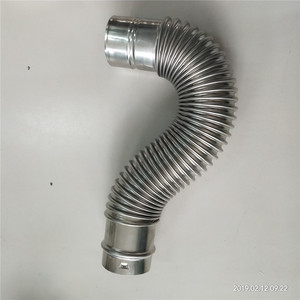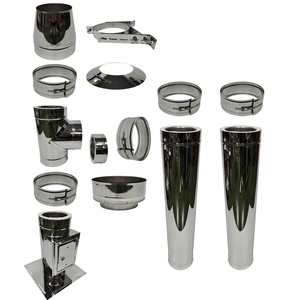(560 products available)















































































































































A flue kit is a vital component for gas appliances. It is an assembly of parts that provide a safe and efficient means for exhaust gases to leave a gas appliance and enter the outside atmosphere. Various types of flue kits are available, including the following:
Concentric Flue Kits:
A concentric flue kit has two pipes, one inside the other. The inner pipe carries exhaust gases, while the outer pipe provides fresh air to the appliance. The design is compact and easy to install. It is suitable for appliances that need a balanced air supply and exhaust. Concentric flues are common in modern gas heating systems.
Horizontal and Vertical Flue Kits:
These kits are configurations based on the direction the flue terminal is installed. Horizontal flue kits run parallel to the ground, ideal for buildings with suitable exterior wall placement. In contrast, vertical flue kits travel upward and are used when a gas appliance is located near a suitable chimney or flue space. Both configurations efficiently vent gas appliances, ensuring safe gas flow and compliance with installation standards.
Balanced Flue Kits:
Balanced flue kits are installed directly on the appliance. They are suitable for appliances that do not rely on chimney ventilation. Balanced flue kits provide air supply and exhaust gas removal. They are efficient and safe because they create a negative pressure environment within the appliance.
Twin Wall Flue Kits:
Twin wall flue kits are double-walled pipes. They are used for highly efficient gas appliances. The design allows for the safe venting of hot gases. The outer wall remains cool to the touch. Twin wall flues are often installed when a traditional masonry chimney is not available but a chimney-like venting solution is needed.
Flue Extension Kits:
Flue extension kits increase the length of an existing flue. They ensure the flue reaches an appropriate termination point. Extensions maintain proper venting clearances and comply with regulations. Installers select the correct extension kit based on the existing flue system's diameter and type.
Vertical Flue Kit with Terminal and Cowling:
This kit includes a vertical flue kit. It also comes with a terminal and cowling. The terminal is the part of the flue that exits the building. It is essential for proper gas ventilation. The cowling is a cover that directs the gas flow. It protects the terminal from the elements. This kit is stable and reliable. It complies with all safety regulations and standards.
Flue kits are essential for safe and effective stove operations. They help vent harmful gases and provide features for safer and more efficient stoves.
Here are some key features of a flue kit:
Ventilation
The main function of a flue pipe kit is to ventilate. A well-ventilated system allows the release of harmful gases into the atmosphere. It also prevents the buildup of smoke, which is dangerous.
U-shaped Flue Pipe:
The U-shaped pipe helps in the proper circulation of smoke and gases out of the house. Its design allows it to navigate corners and obstacles easily. The shape of the flue pipe can vary depending on the installation location.
Vertical Terminal Outlet:
The vertical terminal outlet is an important part of the flue kit. It helps disperse the gases and smoke vertically into the atmosphere. The outlet is installed on the roof of the house. It is suitable for installations in high-rise buildings. It is also great for instances where horizontal dispersion is not possible.
Cowl:
A cowl is installed at the end of the flue pipe. It helps direct the smoke and gases away from the roof and ventilate them. The cowl creates a wind effect that increases the chimney's updraft. It also prevents rain, animals, and debris from entering the chimney. The cowl is usually made of durable metal that can resist high heat and corrosion.
Horizontal Flue Kit:
The horizontal flue kit provides a different dispersion direction. It is a good alternative to vertical dispersion. This flue kit is installed on an exterior wall. It helps release gases and smoke into the atmosphere without going through the roof.
Condensing Flue Kit:
This kind of flue kit is mostly used for modern, energy-efficient boilers. It captures and vents the water vapor created during combustion. The vapor is condensed into liquid form and released through the flue. It improves the efficiency of the heating system.
Durable Material:
The materials used to make flue kits are usually resistant to high temperatures. They also resist corrosion, weather elements, and exhaust gases. Common materials include stainless steel and galvanized steel.
Flue kits are used in a variety of applications. Some of their common usage scenarios are as follows:
Heating Appliances
Flue kits are commonly used with heating appliances, such as wood-burning stoves, biomass boilers, and oil or gas-fired heaters. The flue kit serves as an exhaust system, ensuring these appliances are safely venting combustion gases away from homes. They are also preventing the build-up of harmful gases like carbon monoxide.
Commercial and Industrial Applications
Flue kits are also used in commercial and industrial settings. For example, in factories, power plants, and large-scale food processing facilities, the flue kits are venting exhaust from boilers, furnaces, and other high-heat equipment. These kits are engineered to handle higher temperatures and larger volumes of emissions.
Energy Efficiency
Some modern heating appliances come with advanced flue systems designed for optimal energy efficiency. These systems can recover heat from the flue gases and use it to preheat incoming air or fuel. Such a setup is common in contemporary wood stoves and high-efficiency boilers.
Climate and Location
The choice of flue kit can also depend on the local climate and geographical location. For instance, a vertical flue installation might be preferred in windy areas to reduce the wind's impact on the flue draft. Conversely, horizontal installations may suffice in calmer regions.
Building Regulations
Flue kits must comply with local building regulations and safety standards. This compliance can affect the type of flue kit installed and its configuration. Regulations may dictate flue clearances, materials, and installations, particularly in multi-unit dwellings and commercial properties.
Retrofitting
Flue kits can also be used when retrofitting a new heating appliance in an existing setup. In this case, a suitable flue kit is selected based on the compatibility with the old system and the building's structural features. A proper retrofit ensures the safe and efficient operation of the new appliance.
When choosing a flue kit for sale, buyers should consider various factors to ensure they are selecting the right product for their needs. Here are some of them:
Compatibility:
First, a buyer should consider the type of appliance they have. Different appliances, such as gas or wood-burning stoves, have specific requirements. Therefore, buyers should ensure the flue kit is compatible with their heating appliances. Also, they should check the manufacturer's recommendations to determine the suitable flue kit.
Materials
Business owners should stock up on flue kits made of high-quality materials. The materials should be durable and capable of withstanding high temperatures. Moreover, the materials should be corrosion-resistant. This is important because the flue kit will be exposed to various elements, especially when installed outside.
Compliance
Buyers should look for a flue kit that complies with local building regulations and safety standards. This ensures safe and efficient operation. More importantly, it prevents any legal issues that may arise from non-compliance. Therefore, buyers should take time and review the regulations before making any order.
Installation
Business owners should consider the level of difficulty required to install the flue kit. Some kits are complex and require professional installation, which increases the overall costs. On the other hand, some kits come with installation instructions and are suitable for DIY projects. Business owners should select a kit that is compatible with their budget and needs.
Length and height
The chimney flue kit must be installed at a certain height and length to ensure safe and efficient operation. Therefore, buyers should ensure they have assessed their appliances and determined the appropriate length and height before selecting a flue kit.
Accessories
Buyers should look for a flue kit that has all the necessary accessories for installation. In cases where the flue kit does not come with the required accessories, buyers will incur additional costs trying to get the right accessories.
Q1: What is a flue kit?
A1: A flue kit is a set of components that are used to ventilate gas or oil appliances. The kit provides a pathway for combustion gases to exit the appliance and safely enter the atmosphere.
Q2: What does a flue kit include?
A2: A typical flue kit includes a vertical terminal, pipe joints, bends, a horizontal terminal, and a cowl. The components are installed in a straight line or with one 90-degree bend.
Q3: How does a flue kit work?
A3: A flue kit works by creating a chimney effect. It draws air into the appliance for combustion and expels combustion gases into the atmosphere. This process is powered by the natural rise of hot air and a slight negative pressure created by the flue.
Q4: Do flue kits require maintenance?
A4: Yes, flue kits should be regularly inspected and cleaned to keep them operating efficiently. This is especially true for kits that are installed with a 90-degree bend. Over time, soot and creosote can build up and obstruct the flue. Regular maintenance removes these obstructions and prevents potential blockages.
Q5: Can one assemble a flue kit oneself?
A5: While the components of a flue kit are straightforward to install, proper installation requires knowledge of gas safety regulations. It is recommended that a qualified engineer assemble and install the flue kit.